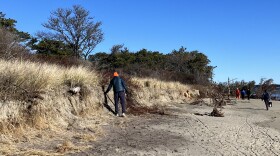July 6 marks the 80th remembrance of the deadliest single building or building complex fire in Connecticut history. The infamous Hartford Circus Fire happened on July 6, 1944. An estimated 168 people died that day, and experts say there were almost certainly more who lost their lives.
Natalie Belanger, a public programs manager for the Connecticut Museum of Culture and History, estimates there were between 8,000 and 9,000 people under the big top that sweltering summer afternoon.
“They're really only a few minutes into this matinee show when a fire breaks out on one of the sidewalls of the tent,” Belanger said. “Some people thought it was part of the act. Some people just thought, ‘well, there's a fire, but they'll put it out. Let's stay put.’”
Roof covered in wax ... and gasoline
The fire soon made its way up the wall of the big top. The situation would take a catastrophic turn when the fire reached the roof.
"When it hits the roof, the big top had been waterproofed with a combination of paraffin wax and gasoline,” Belanger said. “And so when the fire hit that, it just took off and the whole thing burned in about eight minutes.”
Exits blocked
Eyewitness accounts spoke of lethal, molten globs of paraffin wax falling on the panicked people below. Those fortunate enough not to become a casualty of flaming debris, smoke or stampeding feet, often found their path out of danger blocked by a circus wagon or some other misplaced performance related equipment.
“The fire had broken out right next to the main entrance. So many people are heading toward the other exits, but people find obstacles in their way,” Belanger said. “And, that is actually one of the things that most likely caused the largest number of deaths.”
Lawsuits
Today, most would recognize the actions that made the loss of life during the Hartford Circus Fire as grounds for lawsuits. The same was true in 1944.
“I believe five employees of the circus, including a couple quite high up, end up serving prison terms for involuntary manslaughter for not doing their job,” Belanger said. “One of the men was in charge of making sure that the fire extinguishers that the circus brought with them had been put in their places. They had not been. They were left on the trucks.”
Effects of WWII
Eyewitnesses say the Ringling Brothers and Barnum and Bailey Circus had arrived in Hartford far behind schedule after the previous day's performance in another town. Belanger said that tardiness, combined with a loss of manpower to the American armed services fighting in World War II, led to corners getting cut in preparation for the Hartford performance.
“The circus was very understaffed,” Belanger said. “They normally had about 900 people employed to travel the circus from town to town, and [for the trip to Hartford] they only have 600 and change.”
While the war played a role in igniting the tragedy that day, Belanger said it also played a role in limiting casualties.
“The fact that the war was on meant that Hartford and Connecticut had all of these emergency disaster plans in place because of concerns about, say, what if a saboteur blows up Pratt and Whitney,” Belanger said. “So once the tragedy happened, emergency response services were actually quite quick to do their job and well supplied.”
Lessons learned
Belanger said local authorities made changes for the better based on the lessons learned from the Hartford Circus Fire. One of the results in the inquiry made by then-Hartford Mayor Bill Mortenson was an improvement in fire codes.
“The Hartford Fire Department never inspected the circus when it was set up, so the city and the state adopted much more stringent fire codes that became a model throughout the country,” Belanger said.
The Ringling Brothers Circus made changes too. “The next year, I think, they had a new big top, but they now had like designated fire exits,” Belanger said. “They had removed a lot of the obstacles inside the tent that would stop people from being able to get away.”
“People do seem to have learned lessons from this tragedy,” Belanger said, “which is, I guess, the best you can hope for.”





